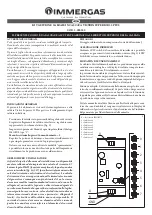
16.1 SAFETY
Switch off the electricity and gas supplies before replacing any
components. After the replacement of any components, check
for gas soundness where relevant and carry out functional
checks as described in Section 13 - Commissioning
16.2 COMPONENT ACCESS
To replace components it is necessary to remove one or more
sections of the cabinet and cover plates within the appliance as
described in Section 15.3. Any 'O' ring or gasket that appears
damaged must be replaced. Complete gasket and 'O' ring packs
are available for the gas and water connections on the appliance.
The facia panel may also need to be hinged down as described in
Section 15.3, c.
16.3 DRAINING THE APPLIANCE
Check that the electricity supply to the appliance is turned off.
Before removing any component holding water it is important
that as much water as possible is removed from the appliance.
(a) Central Heating Circuit.
Turn off the central heating flow and
return valves at the appliance. Fit tubes to the drain taps on the
flow and return manifolds and open the drain taps about one
turn, make sure that the dust cap on the auto air vent is
loosened. See Fig. 18. Close the drain taps when the flow has
stopped. Be careful
not to overtighten
the drain taps. Some
water will remain in the expansion vessel, pump, diverter valve,
water to water and Gas to Water heat exchangers and extra care
must be taken when removing these components.
(b) Domestic Hot Water Circuit.
Turn off the mains cold supply
valve at the appliance and open the lowest hot water tap. A
quantity of water will remain in the Water to Water heat
exchanger and the diverter valve and extra care must be taken
when removing these components.
Replace any components removed from the appliance in the
reverse order using new gaskets/'O' rings/sealant where
necessary. Always check that any electrical connections are
correctly made and that all screws are tight.
16.4 COMPONENT REPLACEMENT
1. Automatic Air Vent.
Remove the inner casing cover as described in Section 15.3 (b).
Drain the central heating circuit as described in Section 16.3 (a).
Remove the circlip and lift the assembly from the appliance.
Unscrew air vent from the pipe. Check the condition of the fibre
washer.
Fit the replacement assembly, making sure the ‘O’ ring is in good
condition.
Ensure that the circlip is correctly fitted and the dust cap is
loosened.
Open the valves and fill and re-pressurise the system as
described in Section 13.2.
2. Overheat Thermostat.
.
Check that the electricity supply to the appliance is turned off.
Remove the inner casing cover as described in Section 15.3 (b).
Carefully pull off the two wires from the thermostat head.
Undo the two M3 screws and remove from the appliance.
Fit the replacement thermostat in the reverse order ensuring that
some heat sink compound is between the thermostat and the
plate.
3. Gas to Water Heat Exchanger.
Check that the electricity
supply to the appliance is turned off.
Drain the central heating circuit as described in Section 16.3, a.
Remove the inner casing cover, overheat thermostat, central
heating sensor, burner and automatic air vent assembly as
described in Sections 15.3, b and g, 16.4, 1, 16.4, 2 and 16.4,
10. Pull down the flow pipe to free it from the heat exchanger.
Disconect the return pipe from the return manifold, turn the pipe
to clear the manifold and pull down the pipe to free it from the
heat exchanger. The heat exchanger can now be pulled down
free of the retaining clips securing it to the flue hood.
Take care that the rear insulation pad does not drop forwards
onto the burner.
Fit the replacement heat exchanger in the reverse order ensuring
that both the “O” rings are correctly fitted and lubricated and a
layer of heat sink compound is on both the thermostats.
16. Replacement Of Parts
Fig.28. Gas to water heat exchanger.
Auto air vent
Gas to water heat
exchanger
Retaining
bracket (2)
Retaining
screws (2)
Overheat
thermostat
Retaining
screws (2)
C.H.
sensor
19
Fig. 27. Burner and Electrode
3-4mm
5-6mm
5-6mm
Spark
electrode
assembly
Spark electrode
detail
Flame
sensor
position
Flame sensor
detail
Burner injector
Burner
Burner
fixing nut
Retaining
clips
Summary of Contents for 24CDi BF
Page 26: ...26 ...
















































